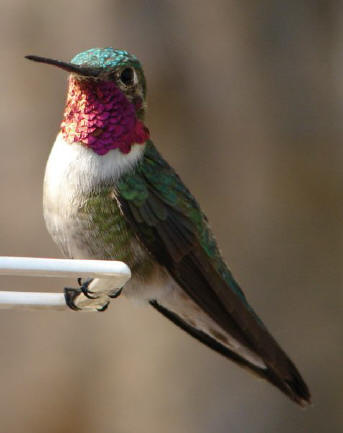Sharon Lance
Adams County Master Gardener
 In spring I look forward to the return of Ruby-Throated Hummingbirds from their migration in Mexico and Central America. They have been known to travel nonstop for over 500 miles back to the states following the blooming season.
According to my brother who lives along the Gulf of Mexico, the hummingbirds arrived in March and left the beginning of April to continue their migration north. Soon we will be seeing hummingbirds in our area. I’ve read that they will return to where they have been previously fed and feeders should be placed outside around
the beginning of April or just before flowers, shrubs and trees start to bloom.
In spring I look forward to the return of Ruby-Throated Hummingbirds from their migration in Mexico and Central America. They have been known to travel nonstop for over 500 miles back to the states following the blooming season.
According to my brother who lives along the Gulf of Mexico, the hummingbirds arrived in March and left the beginning of April to continue their migration north. Soon we will be seeing hummingbirds in our area. I’ve read that they will return to where they have been previously fed and feeders should be placed outside around
the beginning of April or just before flowers, shrubs and trees start to bloom.
The male hummingbird precedes the female’s arrival; and although small in stature, only 3 to 4 inches in length and weighing less than 2 ounces, he will require large quantities of nectar from flowers or feeders to sustain his body temperature and rapid metabolism. These birds prefer a woodland-like
habitat that includes food sources such as nectar, flowers, spiders and small insects as well as a reliable water supply. Trees and woody plants provide shelter and places for them to perch and roost at night. The female will return each year to the same area to nest in the small limbs of trees or woody shrubs using plant
fibers and lichen for nest building. She incubates the eggs and usually has 2 broods, each egg being about the size of a small bean.
 Maintaining proper feeding facilities is crucial to keeping hummingbirds coming back year after year. Unlike other bird feeders, the hummingbird feeder is filled with nectar, not birdseed. This type of feeder can be
purchased at many retail stores, from bird/gardening catalogs or online. It is better to purchase a feeder that has few parts and will be easy to clean. I would suggest that some exterior portion of the bird feeder be red, the hummingbird’s favorite color. The feeders come in a variety of styles, sizes and price ranges.
The birds’ only interest is the nectar not the size or style of the feeder. Because they are very territorial, additional feeders should be hung in locations not visible from existing feeding sites. They should be hung in a semi-shaded area without a lot of foot traffic where you and your family can observe and enjoy the
hummingbirds’ acrobatic behaviors as they hover for a few seconds and then in a flash, dart backwards, up, down and in all directions.
Maintaining proper feeding facilities is crucial to keeping hummingbirds coming back year after year. Unlike other bird feeders, the hummingbird feeder is filled with nectar, not birdseed. This type of feeder can be
purchased at many retail stores, from bird/gardening catalogs or online. It is better to purchase a feeder that has few parts and will be easy to clean. I would suggest that some exterior portion of the bird feeder be red, the hummingbird’s favorite color. The feeders come in a variety of styles, sizes and price ranges.
The birds’ only interest is the nectar not the size or style of the feeder. Because they are very territorial, additional feeders should be hung in locations not visible from existing feeding sites. They should be hung in a semi-shaded area without a lot of foot traffic where you and your family can observe and enjoy the
hummingbirds’ acrobatic behaviors as they hover for a few seconds and then in a flash, dart backwards, up, down and in all directions.
You can purchase a nectar-type product at a store or make your own at home. I make mine by using 4 parts water to 1 part granulated sugar. Boil water, add sugar, and stir until dissolved. If some part of your feeder is red, you don’t need to add coloring to the sugar water, but I choose to add a
little red food coloring. You will only need to partially fill your feeder in spring before the arrival of the hummingbirds; the unused nectar can be refrigerated for up to 2 weeks. Make sure you have nectar in your feeder at all times because hummingbirds have voracious appetites and will satisfy them elsewhere if your
feeder is empty. In the heat of summer the sugar-water mixture can spoil easily, and if that happens, the hummingbirds will not eat the nectar. It is recommended to clean the feeder every 5 to 7 days and more often in mid-summer when the temperature rises and the feeder is more susceptible to mold. Cleaning the feeder is
easy. Wash the feeder in hot water; add some vinegar (vinegar helps retard mold) paying special attention to the feeder openings, which are rather small and difficult to clean. A bottlebrush or pipe cleaners work well to clean these tiny areas. Rinse thoroughly and refill.
Watch out for ants and bees that love the sugar solution. Ants will go to great lengths to eat it. I have been able to keep my feeder free from ants by hanging it from the overhang of my kitchen window. I have been less successful at keeping the ants off my feeder when hanging it from a tree or
shepherd’s hook. An easy way to resolve this problem is by greasing the cord/chain above the feeder hanging from a tree branch with a petroleum product. If the feeder is hanging from a shepherd’s hook, coat it with vegetable oil or a petroleum product. Reapply if it rains. You may also have bees buzzing around the openings
of the feeder trying to eat the nectar. By setting out a small dish of sugar water away from your feeder, you may discourage bees from trying to consume the nectar. But it is important not to harm these beneficial insects.
Hummingbirds are attracted to flowers by their color not their scent because they lack a well-developed sense of smell. They will eat nectar from most flowers but prefer red, orange or pink flowers such as petunias or butterfly weed. It is also important to have long-blooming plants such as Bergamot
and bee balm to provide a continual food source and help keep the hummingbirds returning to your feeder. Because these birds have a long, thin beak and long tongue, it is easy for them to feed from tubular shaped flowers such as trumpet vine. If you have limited ground space outside, consider adding a hanging basket or
window box filled with flowers and plants that will draw them to your garden. Not only are hummingbirds beautiful additions to your garden, they are responsible for pollinating many native plants in the northeastern United States.
In September or early October, Ruby-Throated Hummingbirds begin their migration to Mexico. We have no control over this migration period because it is determined by a photoperiod, a period of shorter days and longer nights. In preparation for their long flight south, hummingbirds will need to
increase their body fat by 50%. Most flowers have finished blooming by this time, so they will rely on the nectar from your feeders to sustain them until they leave. By providing the proper habitat and nectar, you can enjoy these colorful birds in your own back yard for many years.
Read other articles on birds, wildlife & beneficial insects